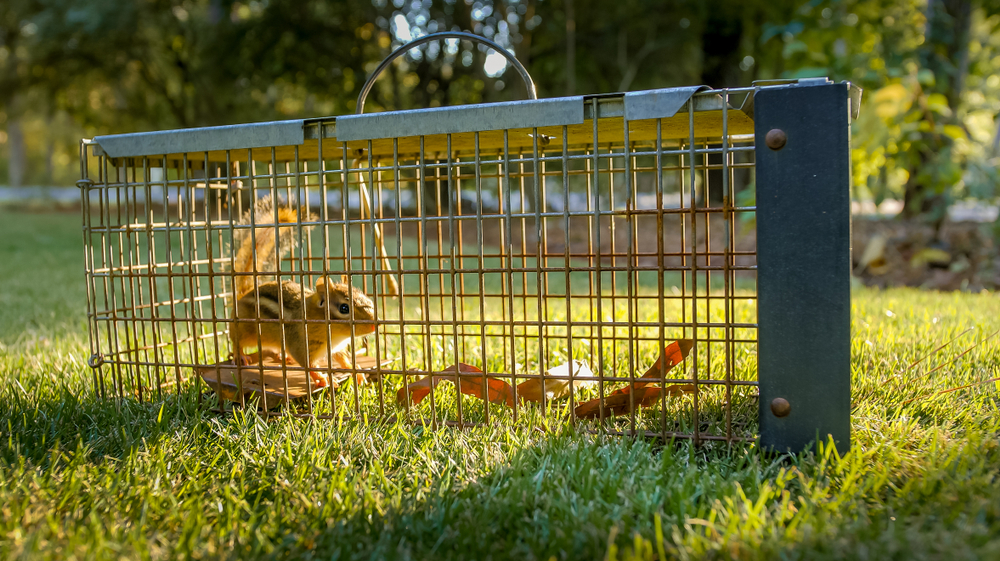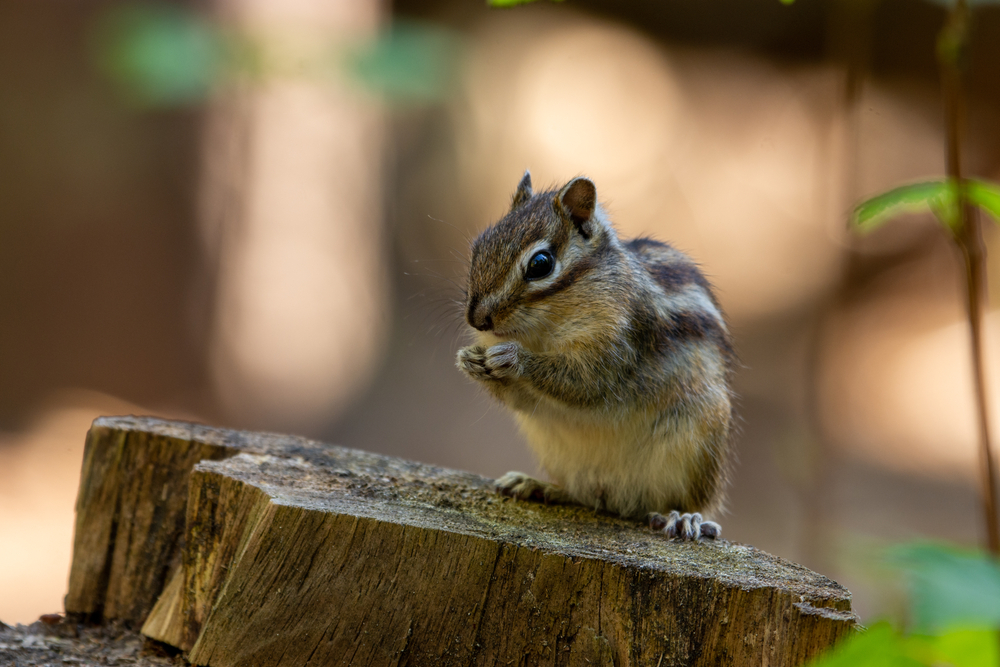Although adorable in appearance, chipmunks are among the most destructive pests to reside in your yard. Not only will they wreak havoc on your immaculately manicured garden, but there’s a chance they’ll burrow beneath the house and destabilize its foundations.
And once these winsome little rodents have set up shop in your yard, they can prove frustratingly difficult to get rid of.
But don’t dismay, for there are several effective ways you can free yourself from these cunning critters—none of which involve cruelty or harm. In this humane how-to guide, we’ll cover the basics of the beasts and discuss how you can evict them from your property for good.
Why Remove Chipmunks From Your Yard?
If you thought Chip ‘n’ Dale couldn’t do any real damage to your home, think again. As cute as they may be, these pesky pests will become a nightmare if allowed to proliferate on your property.
As perpetually peckish omnivores, chipmunks will eat just about anything they can get their claws on. From your prized magnolias to bird feed and the insects that inhabit your yard, nothing is safe from these gluttonous brutes.
And then there are the burrows: tiny little holes that sprout up all over the garden and ruin your entire exterior aesthetic. For the avid gardener, chipmunks are a force to be reckoned with.
But the trail of destruction doesn’t end in the patio, as chipmunks love digging downwards right beside your home. And should they burrow too deep around a load-bearing wall, they’ll compromise the structural integrity of your whole house—that kind of repair work doesn’t come cheap.
Finally, chipmunks can spread a whole host of deadly diseases. According to the Center for Disease Control, chipmunks can transmit tularemia and the plague.
How to Identify a Chipmunk
Before you embark on an epic anti-chipmunk crusade, it’s worth working out whether these are actually the pests you’re up against. Pest control methods vary between species—even rodents—so it’s essential to identify them first.
Chipmunks are most active in mid-morning and mid-afternoon, so pop outside at these times to see if you can spot any scurrying around the yard. Look for a small, agile squirrel-like rodent about six inches long, brown in color with dark stripes down their sides and a white stripe down the back.
If you can’t spot any, search the garden for their burrows—you’ll commonly find these beside walkways. Chipmunks are protective of their homes and will often emit a deep clucking sound as danger approaches.
Preventing Chipmunks From Entering Your Yard
The best way to rid yourself of these rascal rodents is to dissuade them from entering your yard in the first place. If you’re in a high-risk area where chipmunks are a persistent problem, consider taking one or more of the following preventative measures:
- Position a plant-free gravel barrier around the perimeter of your yard
- Protect bulbs with a 1×1 inch wire mesh to prevent chipmunks from digging them up
- Protect garden beds with a ¼-inch hardware cloth to stop them from being nibbled on
- Remove piles of rocks, wood, and clippings from your yard to eliminate potential hidey-holes
- Plant bulbs that repel chipmunks, such as garlic and daffodils
- Install L-shaped footers around your walls to prevent chipmunks from burrowing too close
- Remove shrubs and low rock boundaries near the house to discourage chipmunks from loitering around the foundations
- Prune back any trees, shrubs, and unruly grassland that connects directly to forested areas—a riding lawn mower can help here if you’re working with a sizeable area
- Remove food from your yard, including birdseed and pet food, unless kept in a rodent-proof container
- Use thistle instead of birdseed (chipmunks aren’t fond of the taste)
- Position your bird feeders well away from the house
Get Rid of Chipmunks: Four Humane Options

There are four primary methods you can use to evict Alvin from your home. Each requires a degree of time and effort, so be patient and persistent in your approach.
You may find using a combination of multiple different methods works better than relying on just one.
1. Ultrasonic Repellant
The high-tech solution is to purchase and install an electronic repellent system. Specially designed for rodents of all shapes and sizes (including chipmunks), the device works by emitting a high-frequency ultrasonic pulse through the air and ground. Humans can’t hear it, but the frequency drives critters nuts and sends them scurrying off into the distance.
This model from NIKAND includes a mini solar panel, so you won’t have to bother with batteries or have to plug it into the mains. According to the manufacturer, it’ll take two to four weeks to rid your yard of the pests, so don’t expect instant results. You need to install them every 90 yards or so; don’t worry, four ultrasonic stakes come included in the deal.
2. Live Traps
Live traps are another viable option for cleansing your yard of the crafty critters, and an exciting one at that. The first thing you need to confirm is whether live trapping is legal in your area, as some counties outlaw the practice.
As chipmunks are rather small, use a thin wire mesh trap about ten inches long, like this model from Kensizer — the possum sized ones are too big. Smear a chunk of peanut butter on the trigger plate and place the trap near the busiest chipmunk burrow or walkway, preferably somewhere undercover rather than exposed.
You’ll need to check on the trap frequently; otherwise, the poor little guy could starve to death. Relocate your rodent prisoner in a suitable forested area at least five miles from your house, or whatever distance the law in your area specifies.
While live trapping is superb for removing the odd troublesome chipmunk, the process becomes too laborious when you’ve got multiple critters to deal with.
3. Dry Repellents
Dry repellents have a taste and odor that’s abhorrent to chipmunks, thus forcing them to flee your yard. Simply sprinkle a serving of granular repellent around chipmunk hotspots such as flower beds, garden paths, and your house’s exterior walls. Several different brands compete on the market; we rate Plantskydd Animal Repellent as the best.
Although dry repellents last much longer than sprays, the odor will eventually fade away, at which point you’ll have to lay down more. The product is unpleasant for chipmunks, but at least it’s non-lethal, so you won’t have to worry about inadvertent deaths.
If you’d rather use an all-natural alternative, you could try finely chopped cayenne pepper or even a big bag of human hair (ask your barber for end-of-day cuttings).
4. Repellent Sprays (Liquid Repellents)
Another good option is anti-rodent sprays, also known as liquid repellents. Like dry repellents, these taste unbearable to chipmunks and dissuade them from devouring your plants.
Shake well before use and spray a generous dose over infested areas, paying particular attention to any garden beds you want to protect (don’t worry, it won’t kill the plant life). Do be aware that some commercial-grade sprays aren’t suitable for consumable plants like vegetable patches and fruit trees. If in doubt, check the manufacturer’s labeling.
The big downside to sprays is they don’t last all that long. You’ll need to reapply them frequently, especially after it rains.
Our favorite chipmunk liquid-repellent comes from mdxconcepts, which is non-toxic and emits a pleasant peppermint aroma. Alternatively, an effective natural homemade recipe is to mix up one teaspoon of Lysol, three ounces of Epsom salt, and one gallon of water.
Pro tip: When planting new bulbs in the fall, dunk them in liquid repellent to guarantee they won’t end up as chipmunk food.
How to Get a Chipmunk Out of Your House
Unlike rats and other rodents, chipmunks have no interest in hanging out in your house. If one does happen to wander inside, it’s undoubtedly lost and wants to break free ASAP.
The simplest way to expel a chipmunk from inside your home is to give it an easy escape path. Close all interior doors that don’t lead outside and wait patiently until it finds its way to freedom. In the meantime, keep children and pets out of the picture to avoid cornering and spooking the chipmunk.
If the little guy can’t seem to work it out, you could try using a live trap instead.
Professional Pest Control Services

With a little hard work and perseverance, most homeowners eventually succeed at evicting chipmunks from their yard. The process does take some effort, however, so well-heeled yet time-poor folks might prefer to enlist professional help.
A pest control company will install one or more of the aforementioned methods and provide valuable advice on managing chipmunks and other pests. Of course, the service doesn’t come cheap.
As always, quality varies significantly between companies. To find a reputable operator, Google ‘Pest Control Services Near Me’ and compare the online reviews.
How to Get Rid of Chipmunks: Final Thoughts
Whether you’re a passionate gardener or you’re nervous about burrows by your home, chipmunks are a malicious household menace—albeit an adorable one.
Use our list of preventative tips to stop chipmunks from taking up residence in your yard. And if you’ve already got a furry squatter or two, try one or more of our four practical ways to evict them.
